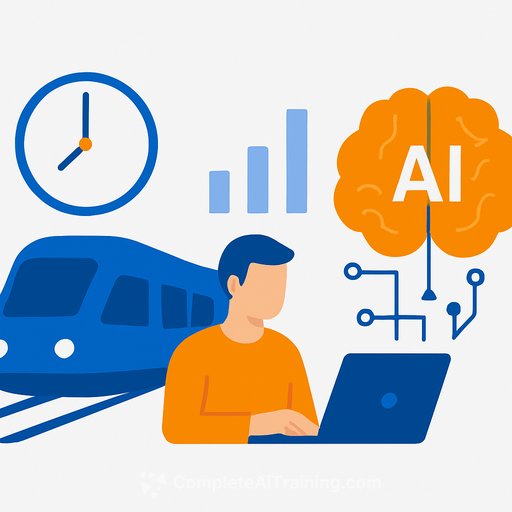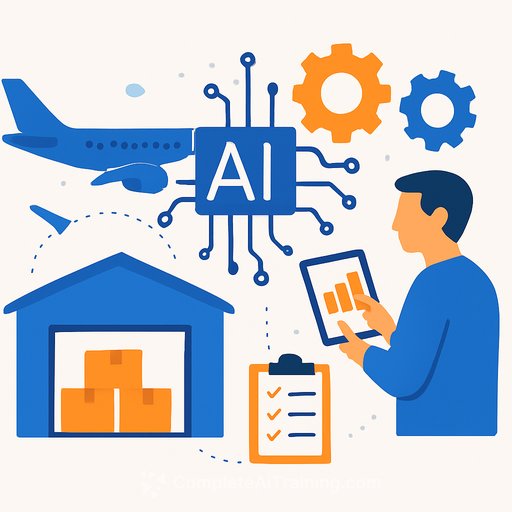Intelligent Rail Summit '25: AI that makes rail operations more resilient and punctual
Published on 17-10-2025 at 14:00
In rail operations, seconds compound. DB InfraGO's AI-based dispatching assistant, ADA-PMB, helps dispatchers decide which train goes first, which waits, and how to keep traffic flowing when disruptions hit. "If trains are dispatched as recommended, that is on average a 100-second gain per dispatching in the Frankfurt region," says Hannah Richta, Head of Algorithms for Operations at DB InfraGO.
That may sound small. But with hundreds of recommendations per day in a dense network, those gains stack up fast and reduce knock-on delays across corridors.
What ADA-PMB does in practice
ADA-PMB generates actionable recommendations every minute based on live train positions, infrastructure availability, and traffic rules. The guidance includes overtakes, track changes, and crossing priorities.
- Time budget: solutions must compute within 60 seconds or they lose value
- Methods: a mix of mathematical optimisation, heuristics, and machine learning
- Output: clear, ranked options for dispatchers to accept or ignore
Fair treatment is non-negotiable. The Bundesnetzagentur checks the models to ensure no operator is favoured. "Mathematical optimisation makes this transparent - pure machine learning would be harder to explain," Richta notes.
Results so far
Pilot work started in 2020 in Berlin with local trains at similar speeds - a controlled environment to tune the models and speed up computation. Since then, ADA-PMB is active in four regions, including Frankfurt and the Munich-Lindau corridor, with pilots in Stuttgart and North West Germany.
In Frankfurt, each accepted recommendation saves about 100 seconds across affected trains. In a hub where one delay can cascade, those savings protect the wider timetable.
Built for real-time operations
Richta's team focuses on trains already on the tracks - not long-term timetabling or maintenance. The goal is fast, fair decisions that reduce system-wide delays when plans break.
- Minute-by-minute recalculation as the situation changes
- Priority logic aligned with rules and neutral to operators like DB and Flixtrain
- Dispatcher-in-the-loop with accept/decline controls
Adoption: start small, learn fast
The team spent time on shifts with dispatchers, built feedback loops, and shipped small improvements quickly. Simple thumbs-up/down inputs feed back into the next iterations.
- Choose a manageable pilot scope (uniform speeds, clear rules)
- Blend optimisation, heuristics, and ML to meet strict time limits
- Co-design with users; measure both acceptance and delay impact
Weather, climate, and disruption resilience
Extreme weather is increasing. ADA-PMB's logic can extend to bigger incidents like landslides or fallen trees, where parts of the network go offline. The team is discussing modules to reroute traffic at scale and reduce secondary delays.
- Near term: use weather forecasts to pre-position crews and plan diversions
- Next: sensor data on locomotives to flag risks like unstable vegetation
- Goal: faster re-planning when infrastructure is partially unavailable
Governance and risk
Regulatory scrutiny is demanding but useful. "We have the safety of knowing our system is certified as fair. That's better than investing millions only to face legal risks later," says Richta. Transparent rules and audit trails keep trust high with operators and regulators.
Integration and scale
The next milestone is to embed ADA-PMB directly into dispatchers' screens by the end of 2026, replacing the extra monitor. Rollout is planned at a few regions per year, subject to funding and political priorities.
- Platform: the new dispatching system, LeiDis-D, enables faster integration
- Capacity: a core team of 15 plus ~30 external developers
- Constraint: digitalisation backlog requires steady investment and support
Richta is clear: "Digitalisation is essential for the future of rail." The direction is set despite leadership and political shifts.
What operations leaders can apply now
- Set strict compute deadlines for real-time decision support
- Blend methods: optimisation for transparency, ML for speed, heuristics for edge cases
- Start in controllable segments, then scale by corridor
- Keep dispatchers in the loop with simple acceptance controls and feedback
- Build auditability to satisfy regulators and partners
- Instrument the network - weather feeds and onboard sensors reduce surprise
- Plan integration early; parallel screens slow adoption
See it at Intelligent Rail Summit
Hannah Richta will share ADA-PMB's development, pilot results, and join a panel on AI in rail at the Intelligent Rail Summit in Slovenia on 5 November 2025. The event focuses on data-driven resilience, including satellite and drone monitoring, real-time diagnostics, and predictive maintenance.
Upskill your team
If you are building AI fluency across operations teams, explore practical learning paths by role at Complete AI Training.
Your membership also unlocks:






